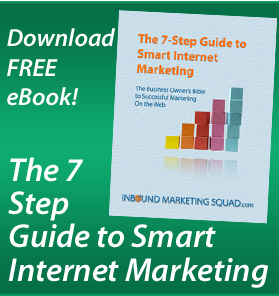Yes. It does. [Not a happy answer, but a truthful one.] "But why?" I can hear you wail. "I just redesigned my website, it's really cool, lots of videos and graphics, great shopping cart. I've got an SEO consultant who keeps tweaking my pages so I stay on top. Why do I have to do this?"
redesigned my website, it's really cool, lots of videos and graphics, great shopping cart. I've got an SEO consultant who keeps tweaking my pages so I stay on top. Why do I have to do this?"
Well, you don't have to publish a lot of content. That's a business decision. And I'm sure your SEO consultant is doing a very good job trying to keep your existing web pages optimized. But the reality is, whether you or I like it or not, your prospective customers won't find you on the Internet with one static web page (or 50) about your products or services.
Optimizing your standard web pages is great. But that's only only a very small part of getting your site to appear at the top of the search engine results pages (SERPs). Why is that?
The Content Glut
Because attracting the right traffic to your site is unbelievably competitive today. And it's getting tougher every second because of the sheer VOLUME and FREQUENCY of content being published, emailed, shared, tweeted and liked.
To give you an idea of just how much content is being created, read Technorati's 2013 Digital Influence Report. Look at Domo's infographic up above that talks about how much and what activities are taking place on the Internet every MINUTE of every DAY. (Click on it to see the original article and infographic.)
Now let's complicate things (as if you didn't have enough to worry about). Google (and other search engines) makes money selling advertising. It can only do that well if it has lots of users on its search engine. The only way people will use Google is if it helps them find exactly what they're looking for (oh, and by the way, help them even if they don't know exactly what that is).
This has forced Google to get very, very smart and very, very selective with its fancy search formula (algorithm). It is continually tweaking and testing it so that it is delivering the content searchers expect to find when they go search with Google. So what that comes down to is that there are only 10 slots per keyword that matter in "natural" (or organic) search. If you're not one of those first 10, chances are that no one will find you. (Only 10% of searchers go beyond page 1 of search results.)
 Now there's a double-edged sword to this phenomenon.
Now there's a double-edged sword to this phenomenon.
Edge 1 is all the gazillions of companies competing for those very same keywords. But because of that limitation, and the big brands who typically dominate those types of keywords, the little guys are left out in the cold. Small businesses just don't have the resources to compete with creating the volume and frequency of content or pay the big bucks for the PPC ads for those keywords.
Edge 2 is that the average searcher may not want what those big brands are publishing — or the solutions presented on those keyword search results are so vague, that the searcher has a hard time finding what she wants. How many times have you typed something into Google only to be presented with stuff that's not even close to what you're really trying to find?
Searchers Don't Always Know What They're Looking For
Some of that is because most people aren't adept at using a search engine. They just type in what they're thinking. So Google has to be smarter than them. It does lots of things: like anticipates if you've spelled something wrong and offers you a more popular search phrase. Or it offers other related search phrases. All in an effort to understand what you really mean and help you find what you want.
If I typed in "women's bicycles," the page fills with bicycle manufacturers and big department stores. Which is fine if I was ready to buy a bike and knew exactly what I wanted, because the results are all from companies showing me bicycles I can buy.

But what if what I really wanted was to find someone who could help me solve my problem? (I've got short legs and can't ever find a comfortable bike.) Chances are very high the answer isn't in those results. Because maybe the solution isn't a woman's bike. When I went searching, I assumed "woman's bike" would take me to the information I needed to solve my problem. But I don't know enough yet, and there could be better choices for me.
So now I type in "bicycle for short women". Look how the results have changed! Here I've found a blogger who discusses bikes for short women in depth, the LiveStrong Foundation's blog post with other good info and two discussion forums on the topic. That's the kind of information that can help me!

Here you can see Google's smart search formula at work - it even shows me alternative language such as "petite women."
The difference between the two phrases "women's bicycles" and "bicycle for short women" is a magnitude of difference for me as bicycle shop owner.
The first one is what I need in my web page navigation for my store. It's a head keyword, which are are the keywords most SEO technical experts will advise you to put on your site's main pages (rightly so) so your site can be found and classified by search engine spiders, and make it easy for your visitors to navigate your site once they go there. Head keywords are usually fought over by the big brands when it comes to natural search results. They're the ones spending bazillions of dollars every year on creating content and buying PPC ads.
But "bicycle for short women" is a more specific type of keyword phrase we call long-tail keywords (LTKs for short). LTKs are a marketer's gold mine for two reasons:
- They're typically not as competitive, making it easier for you to create content that can lift you into the top 10 of the SERPs and
- Because searchers use them to find precisely what they want, you're getting more qualified traffic.
So while the monthly search volume won't be as great as with the head keywords, you have a better chance of being found by qualified traffic with LTKs because they're not so competitive. And while this is a smaller part of a bigger pie, the people using much more specific keyword phrases are more likely to be interested in your site and more likely to convert into a qualified lead and/or become a customer.
You wouldn't write about "bicycle for short women" if you didn't have a solution related to that topic, would you?
So what does all this SEO and keyword stuff have to do with creating content?
Google wants to know that your site is "alive." That it's not a ghost town. That there's a real business behind the site with people producing what searchers look for. Thus the frequency, and regularity of new information that's published is embedded in its formula. This information tells Google you're a live, on-going site with fresh, new content. (New content also implies it's more accurate.)
Most websites are electronic brochures, the equivalent of digital ghost towns. Many business owners create a website only to let it sit there, except to put a new promotion/sale notice on their home page every so often (if that much). Smart business owners have created a blog where they post lots of new information on a regular basis. And they optimize those different articles using long-tail keywords.
Combine that "keyword stuff" with producing new content on your site's blog and you're creating the ideal conditions that will enable your ideal prospective customers to find you on the Internet.
Google also takes into account how often someone clicks on your information, how long they take to read it, whether or not they go on to other pages on your site, if they share that information with other people via Google+, Facebook, etc. Google looks to see if other people put a link to your information on their web sites, or if someone emails your page (via Gmail) to someone else. The more of this activity that happens, especially if these other websites have high marks from Google for producing good content, and that the emails aren't from "spammers," that goodness gets passed along to your site. This is what the experts say Google determines originality, relevance and usefulness.
Never forget that people searching on Google are looking for answers to problems they have. We live in the world of do-it-yourself, self-service, and self-education. People don't want to be assaulted by marketing messages. They want information so they can make their own decisions. Your job is to provide that information, in as many thousands of different ways you can imagine - because few people look at a problem exactly the same way.
Once Isn't Enough
But publishing one blog article isn't enough. Publishing articles for a few weeks or months isn't enough. In fact, if you want to effectively compete on the Internet and grow your business, you have to regularly publish great content for as long as you want to stay in business.
And if you're like most business owners, you're reluctant to commit the resources (money, time or labor) to feed the content monster. There are so many other more crucial things that need your attention and this is the last thing you want to deal with.
I empathize. Truly I do.
I'm no different than you. I too have to feed that content beast if I want to be found on the Internet. And I often resent having to commit resources I'd rather spend elsewhere. It's either pay a professional or stay up late at night / sacrifice my weekends to write content for my site.
Internet. And I often resent having to commit resources I'd rather spend elsewhere. It's either pay a professional or stay up late at night / sacrifice my weekends to write content for my site.
All of this reminds me of the late-'80s, after the Macintosh was launched. The world of publishing and communications was forever changed — much the way Gutenberg's printing press revolutionized how books were produced.
Think about it. Before the Mac came along, to produce a newsletter, brochure or flyer, you hired a commercial artist and a copywriter to create them. With the Mac, we had Desktop Publishing! Hurrah! Now anyone with a Macintosh, software, and a LaserWriter could write and produce their own newsletters, brochures, flyers and direct mail postcards. And boy did we ever. It wasn't long before the world was deluged by really, really badly designed and unreadable "junk." And the ramifications were...
Direct mail response rates plummeted. Billions of dollars was wasted on marketing collateral that was never read and instead went into landfills and recycling bins. (I remember even at Apple we spent $25M a year in the U.S. publishing brochures, etc. back then). So to stand out, businesses once again turned to the professionals to produce content.
Fast forward a few years to the Internet taking off. Once the province of coders and hackers, now "everyman" is armed with digital cameras, laptops, smartphones and software like iMovie, WordPress, Tumblr, Blogger, Facebook, YouTube, Instagram,...... And once again, anybody can publish anything, only this time, the content is accessible to billions of people within seconds of being published.
Again, history repeats itself. YouTube used to belong to amateur videographers producing viral videos. Today it's virtually impossible to get to the top of YouTube and/ or go viral if the video isn't professionally designed and produced. And I believe that the same is rapidly becoming true with more "standard" content such as blog posts, white papers and eBooks. Quality will once again outweigh quantity.
Nonetheless, the dilemma remains about how can you and I get found on the Internet if we don't follow the proven facts about publication frequency and volume.
It all comes down to: how quickly do you want to be found and by whom?
How important is getting a lot of traffic, and how fast, to you? How qualified do you want that traffic to be?
You have a decision to make. Either you commit resources that will get you the results you want when you want them, or you must adjust your expectations to reflect the resources you're willing to commit.
It's not an easy question to answer. What are your thoughts? What trade-offs will you make? What won't you do? Tell us in the comments below.
Related Articles:
- What's A Marketing Funnel? What's A Sales Funnel?
- How to Tame the Content Beast
- How Can Inbound Marketing Help A Local Small Business Grow
- Your Business Blog Helps You Get Found Forever
- How to Optimize Your Marketing Funnel, Part 1








